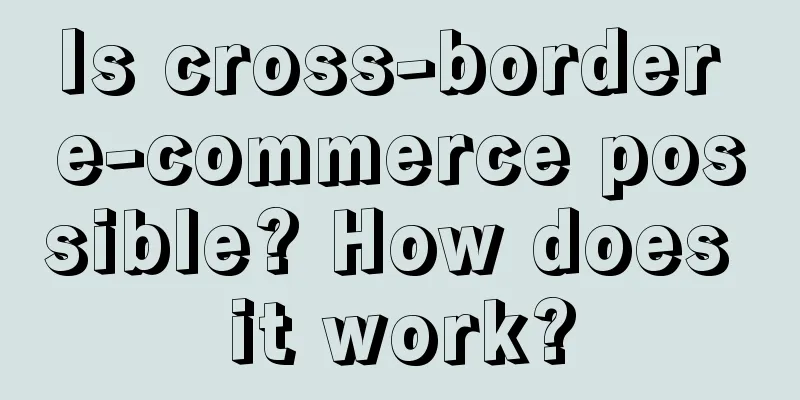Spring Festival orders increased 100 times month-on-month. How can WeChat stores seize the opportunity?

The launch of WeChat Stores in August last year redefined the “atomic components” for conducting transactions within the WeChat ecosystem; and once the “gift-giving” function was launched in December, the “little blue bag” became a hot topic in the industry, and was even called a new outlet for “WeChat e-commerce” in the industry. According to the 2025 Spring Festival data report released by WeChat, the launch of the "Little Blue Bag" during the Spring Festival has greatly increased the order volume of snacks, candies, plush toys, books and other categories, among which the order volume of books has increased by more than 100 times month-on-month. However, despite the strong growth momentum in transactions, many merchants and consumers still feel flaws in the experience during actual application. For example, a blogger on Xiaohongshu pointed out that he used the gift-giving function of WeChat Store to send chocolates to his friends on New Year's Day. The details page stated that the goods would be shipped within 48 hours, but there was no response after 6 days. Neither the merchant nor the official customer service of WeChat Store could provide a suitable solution. On the business side, some merchants also complained that the customer service function of the store could not count reception data and could not find customers through orders, which greatly affected the operating efficiency. However, what’s interesting is that Tencent seems to have anticipated the operational experience flaws in the short term. Since the launch of WeChat Mini Stores, not only has there been little official fanfare for the launch of WeChat Mini Stores and the “gifting” function, but senior management has also personally stepped in to reduce the hype. At Tencent's annual meeting in early January, Ma Huateng expressed the hope that the outside world would not over-hype the (gift-giving) function, and that WeChat would take five years or even longer to become an e-commerce ecosystem connector. As a social ecosystem with the largest user base, WeChat has irreplaceable business value. So how should we understand WeChat Stores, and what opportunities and possibilities are worth paying attention to? In response to the above questions, we talked with Jian Feng, CEO of Zero One Digital Technology, Lucas, head of Zhuoer Private Domain, and Rong Ge, business director of Runyu Team. 01 “WeChat Stores indicate that WeChat wants to reclaim data rights”"WeChat Stores indicate that WeChat really wants to take e-commerce seriously." In Lucas' view, the launch of WeChat Stores indicates that WeChat wants to reclaim data rights. Data is the lifeblood of e-commerce and the guarantee of operational efficiency. However, previously, WeChat only had WeChat Pay as a gateway to capture transaction data, while user behavior data was scattered among service providers (such as Weimeng and Youzan), and WeChat did not compulsorily collect it. As a result, WeChat does not have enough behavioral data to label users with high precision. This is also one of the important reasons why it has been criticized by merchants for being "difficult to attract traffic". The emergence of WeChat Stores has given the opportunity to unify the "shelves" in all transaction scenarios within the WeChat ecosystem. In this way, WeChat can collect all the user's full-link behavior data from content browsing to ordering. With complete full-link data, it is natural to improve the accuracy of user behavior labels. Not only about data, but also at the operational level, the emergence of small stores provides the basic conditions for improving the commercial efficiency of various ports within WeChat. In the past, the traffic of video store accounts came more from video accounts. But WeChat stores can connect all ports in the WeChat ecosystem to help merchants increase exposure and conversion efficiency. On the public side, WeChat stores can access traffic from video accounts, public accounts, Moments ads, and SouSou, and on the private side, they can be combined with social groups, corporate WeChat, etc. This means that some content ports that originally had weak commercialization capabilities due to blocked transaction links now have new opportunities. The most typical carrier is pictures and texts. Now the updated WeChat public account pictures and texts can directly jump to WeChat stores, and the little green book can also carry product links. The Little Green Book can directly jump to the WeChat store product page Lucas said, "Official accounts will be revived, and categories suitable for pictures and texts will also have growth opportunities," such as books and fragrances. These categories need to be accompanied by text to convey product stories and values, and have the opportunity to quickly grow out of WeChat stores. The private domain has always been WeChat’s irreplaceable ecological advantage compared to other platforms. One of the earliest business forms in the WeChat ecosystem is the Wechat business based on private domain operations. However, due to the lack of supervision and the opacity of the transaction link, private domain transactions have always been in a gray area. When mentioning Wechat business, most people's first reaction is "cutting leeks". Taking over the infrastructure of WeChat Stores, WeChat launched the "Tui Ke" function at the end of last year, making it possible to trace private transactions. Through the WeChat Store Preferred Alliance's Tuike distribution API interface, "Tuike" with accumulated private domain resources can cooperate with sales agencies to promote products in WeChat ecological scenarios such as communities, official accounts, and video accounts. On the one hand, promoters can use their own private networks and influence to accurately connect merchants with potential consumers, and leverage the trust between WeChat friends and community members to increase product sales and exposure. On the other hand, through product cards with WeChat Store API interfaces, WeChat can track and secure every transaction. However, the real promotion of this function will only start in the first quarter of 2025. It is too early to judge whether it can really bring business growth to merchants. At present, as an atomic component, WeChat Store plays the role of a connector within the WeChat ecosystem, connecting independent ports to form a more closely connected and efficient collaborative network. Although this connection provides convenience and possibility for merchants to integrate WeChat ecological resources and promotes the flow of traffic and data at various ports, as always, WeChat does not want to directly participate in the business operations of merchants. Just like, even though WeChat Stores play a function similar to that of a "shelf", what WeChat wants is definitely not to become another shelf e-commerce company. 02 Connector of e-commerce ecosystem: Breaking the low-price involution with “social + content”"Tencent will leverage its social capabilities to make WeChat an ecological connector for e-commerce." As Ma Huateng said, social networking is still the core driving force within the WeChat ecosystem and its unique differentiated advantage. This is reflected in the product display and recommendation mechanisms within WeChat stores. The recommendation algorithms of traditional e-commerce companies are mainly based on users' personal behavior data, such as browsing history and purchase history, to recommend products. However, WeChat stores will directly display how many friends have given or purchased each product, strengthening the influence of acquaintances on transactions. By showing friends' purchase behavior, the trust and influence of social relationships can be used to promote transactions. In the WeChat ecological content dissemination logic diagram of Zero One Digital Technology, WeChat has a triangular cycle of "content-social-commercialization". In Jianfeng's view, the "little blue bag" gift-giving function launched at the end of last year belongs to the content part. If we understand gift giving in the context of transactions, it means giving commodities the ability to express content and convey emotions, allowing them to circulate in social relationships. However, the premise for this concept to be established is that social relationships exist in the transaction ecosystem. This is exactly where WeChat’s advantage lies. Earlier this year, Zhang Xiaolong said that WeChat’s starting point for engaging in e-commerce was that it felt the e-commerce market was very competitive and that the phenomenon of competing on low prices was not healthy. WeChat hoped to help practitioners do meaningful things together and do it in the long run. Giving gifts is actually a concrete manifestation of this value. In the gift-giving scenario, the buyer's definition of the value of the product will change. Price is not the primary factor affecting consumption decisions, emotional value and quality-price ratio may be above it. Unlike buying something for yourself, the essence of gift giving is to convey emotions. The more important measure of the value of a gift is whether it can convey the friendship that the gift giver wants to express. According to Tencent Marketing Insights, the most preferred gift characteristics of gift givers are "can reflect personality and uniqueness (accounting for 62.7%)" and "can express thoughts and emotional value (accounting for 60.7%)". These demands can all be reflected in specific product strategies, such as: whether the pricing of the gift product is affordable for the gift giver, whether the gift recipient can accept it with peace of mind; whether the product packaging is appropriate... If merchants are well versed in this series of completely different evaluation systems, they can escape from extreme price wars. During this year's Spring Festival, we can see brands that seized the gift-giving scene and reaped social dividends, Juewei is one example. On the eve of the Spring Festival, Juewei’s WeChat store launched a 98-yuan “Fortune Explosion” gift box and a 168-yuan “Burial Blessings” gift box. All of them were sold out on New Year’s Eve. At the same time, the content received over 1 million exposures, increasing the efficiency of social fission by 300%. Compared with the average price of "little blue bag" which is less than 100 yuan, the price of Juewei gift box is not low. The reason why consumers pay for it and bring brand communication effect is that it grasps the psychological needs behind gift giving and quickly understands and responds to fans' needs. According to the Juewei team, they initially wanted to make the blue bag because they noticed a fan shouting on a social platform, "I want to give Juewei as a gift for the Chinese New Year WeChat blue bag." Later, fans also participated in the selection and design of the gift boxes. As for products, although price is not the core factor in gift-giving, the giver still hopes that the recipient can intuitively feel that the gift has high value. Therefore, both of Juewei’s gift boxes only use pure meat products to enhance the sense of value that can be seen with the eyes. On the other hand, gifts also need a sense of ritual and uniqueness. Juewei's gift box packaging design expresses the auspicious meaning of "surging wealth" and "full of blessings" in a national style, which can just meet the emotional needs of users for Chinese New Year gifts. The strong supply chain capabilities also allowed Juewei to complete the entire process from project establishment to WeChat store release within 7 days, ensuring the timeliness of holiday communication. Of course, the birth of any new thing is inevitably accompanied by immaturity, and the "little blue bag" is no exception. Many industry insiders revealed that the actual success rate of gift giving is between 40% and 60%. Obviously, a success rate of less than half is not a satisfactory result. But this is not surprising to everyone. After reviewing the gift giving during the Spring Festival, Rongge found that there are mainly three types of people who failed to receive gifts successfully. The first category is that WeChat has not been updated and does not support the gift receiving function; the second category is that they think that "one-click gift receiving" does not conform to the Chinese etiquette of "one push, two concessions, and three acceptances", but after sending the gift, adding a blessing explanation like "good luck and good fortune" can basically dispel the other party's concerns; the last category is that after receiving the gift, they did not fill in the address and did not know the acceptance process. The third category is the most common. In Rongge's view, the "little blue envelope" is similar to the WeChat red envelope ten years ago, and filling in the address for receiving gifts during the Spring Festival is similar to binding the card first to grab the red envelope during the Spring Festival Gala. Social scenes similar to "giving gifts" can quickly implant the idea of "WeChat can be used for shopping" in the minds of users, further increasing the penetration rate. This is the biggest opportunity for WeChat to connect with e-commerce. Jianfeng's view is similar. After analyzing the data, he found that 50%-60% of the users who made transactions through WeChat gift-giving were new users who had never made transactions on brand mini-programs. In terms of categories, during the Spring Festival, the dominant categories of WeChat gift-giving were mainly food, books, etc., which was very different from the clothing category that originally dominated the video account. This shows that compared to increasing the overall transaction volume, the more important value of gift giving lies in expanding WeChat’s business ecosystem, increasing product category opportunities, and implanting it in consumer minds. 03 Stay calm in the short term, find the right position and plan for the long termIf small shops and promoters are effective paths that can accelerate commercialization and have lessons learned from the past, then "gift giving" should be considered an innovation and surprise, a new attempt with unknown results. This unpredictable innovation is what makes WeChat so exciting. “We never know what changes it will make next. WeChat always brings new things to the industry,” Lucas said. "WeChat's new products usually take 3-5 years to mature." In Lucas's view, as a product covering more than one billion people, WeChat seeks to adapt to a wider range of people and cover a longer period of development. Therefore, it is expected that new products will have some imperfect functions in the short term. Brand merchants who want to enter the WeChat ecosystem should also be prepared to see the long-term value. In addition, WeChat's commercialization path has always followed the underlying philosophy of "tools are ecosystems". The foothold of small stores is ultimately products, which are atomic components within the WeChat ecosystem that encapsulate product information, undertake transaction functions, and carry transaction data. Therefore, facing the huge WeChat ecosystem, brands that want to enter need to find the unique value of each product to their own business and link them together in a way that suits them. "In the WeChat ecosystem, business success depends greatly on strategic organizational capabilities. Brands need to find their own ecological niche," Jianfeng believes. For example, brands with a private domain foundation are more suitable for self-broadcasting, just like the coffee brand Luckin Coffee, which already has tens of thousands of stores, and traditional footwear and clothing brands that have built offline store networks. In the past, categories such as food and beverages that had a weaker private domain foundation could also use the social scene of "gift giving" to boost small store sales. At the 2025 annual meeting, Zhang Xiaolong said that developing new features is risky, difficult and uncertain, and people are used to pursuing certainty. However, certainty cannot bring surprises, and one reason for the failure of a business is that everyone is doing the right thing. Regardless of success or failure, being able to propose new possibilities for the current industry environment with severe internal circulation is ultimately something worth looking forward to. References: 1. Tech Planet. 2025.1. Ma Huateng: I hope the outside world will not over-hype the WeChat “send gifts” function 2. China Business News. 2025.1. E-commerce is worth doing for a long time. Zhang Xiaolong, the father of WeChat, talks about the starting point of WeChat’s e-commerce business. 3. TMI Tencent Marketing Insights. 2025.2. "A Panoramic Report on Spring Festival Gift Giving": From Red Envelopes to "Online Gifts", the Upgrade of New Year's Ritual Sense Author | Li Zi |
<<: The key to understanding the battle between JD.com and Meituan is human resources
>>: Say goodbye to confusion! A guide to developing data analysis ideas
Recommend
How much does it cost to deliver from South Korea to China? How is the delivery fee calculated?
When we shop online, shipping is usually free in J...
The copywriters with a monthly salary of 50,000 yuan are all writing fences
Fences were originally a common tool used to block...
“Who will be the next brand to be swallowed up by Douyin’s traffic?”
Today’s Internet traffic can make some brands succ...
Look! 3 steps to quickly find blue ocean words on Xiaohongshu
Introduction: Brand "blue ocean" refers ...
Semi-automatic, hand-poured, bring your own cup - details and reversals behind the Manner incident
As the coffee-throwing incident at Manner continue...
Spending 30 yuan to eat grass fodder, nearly 3 billion people watched on the Internet, foreign university canteens have become the new traffic code
International students have attracted a lot of att...
Can I return products from Lazada after 7 days? How long is the return period?
When shopping online, some friends want to apply f...
Member Upgrade Campaign: A Strategic Guide to Exploring User Potential and Scaling Up Average Customer Price
In the stock era, commercialization is particularl...
Short dramas on the Internet: from long to short, from short to micro
As people's time becomes fragmented and they w...
With sales of 5 million overnight and an increase of over 4 million followers, it took on the heat of the "business war", but is the challenge just beginning?
As the incident of a head anchor fermented, the he...
Does Amazon Merchant Manager charge any fees? What are Amazon's fees?
Nowadays, more and more merchants are opening stor...
Items that cost less than 10 yuan are also free shipping, where is the profit point?
The e-commerce logistics industry is becoming more...
How to do wish? How much money is needed?
Wish is a world-renowned e-commerce platform that ...
Can Chinese people still open a store on Etsy? How to open a store on Etsy?
Currently, the Etsy platform only accepts sellers ...
Over 500 million people are addicted to short dramas, and Douyin, Kuaishou, iQiyi and Tencent Video are competing again
Recently, short short dramas have become popular a...









